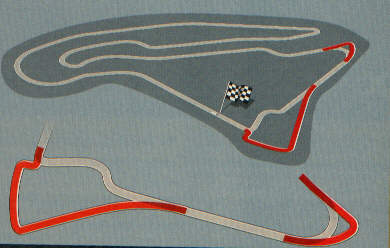 It had long been the thought that the only passing place on the track was the
Adelaide hairpin, so for 2003 they sought to remedy this by reprofiling the track,
as shown left. This extended the track to ?.
It had long been the thought that the only passing place on the track was the
Adelaide hairpin, so for 2003 they sought to remedy this by reprofiling the track,
as shown left. This extended the track to ?.
Click here for the pre-1991 map.
Circuit de Nevers - Magny-Cours Technopole 58470 Magny-Cours France Tel: +33 86218000 Fax: +33 86218017Length: 2.65 miles
Formerly known as the Circuit Jean Behra, and was best known as home to the Martini chassis constructor. In the 1980s President Mitterand supported moves to relocate the Grand Prix here, and the circuit was revamped for 1991.
The circuit was active from 1961, at 1.24 miles. In 1971 it was extended to 2.361 miles, with a further 0.3 miles being added in 1981. Between 1989 and 1991 the circuit was refurbished, and in 1992 the chicane at Adelaide was bypassed. There was also a link constructed between Adelaide and Chateau d'Eau, but this has never been used for racing and is now a service track.
 It had long been the thought that the only passing place on the track was the
Adelaide hairpin, so for 2003 they sought to remedy this by reprofiling the track,
as shown left. This extended the track to ?.
It had long been the thought that the only passing place on the track was the
Adelaide hairpin, so for 2003 they sought to remedy this by reprofiling the track,
as shown left. This extended the track to ?.
You come past the pits and you are into sixth just before you turn flat into the first corner, Grande Courbe. It's fast, but there's nothing to it really, you've got plenty of road on the exit. then it's back down to fifth with a small amount of braking before the right-hander (Estoril) through which you're just trying to build as much speed as possible all the way through the corner.
It's a long way around that corner and then onto the end of the next straight so a mistake can make a big difference to the lap time.
At the end of the straight you get onto the brakes very hard for the hairpin, which is modelled on the hairpin at Adelaide. This is about the only place on the circuit where you can overtake, although it is possible at the 180 degree corner after the Nurburgring and at the chicane just before the final corner.
Nurburgring is interesting. It's a quick change down to fourth and then a quick flick right and left. You can use the kerbs on both parts, and it's quite difficult. It's the type of corner that sorts out some of the better drivers from the rest.
Finding the braking point for the next corner (180 degree) is quite difficult. You brake as you turn in and so the back of the car is always trying to step out. The track is quite slippery there as well which makes it even more difficult. But the exit is really just a turn and squirt, and then you accelerate hard through the little kink towards Imola, which is another good corner.
There is a dip in the middle, which makes the exit blind, and the car goes quite light over the brow on the exit. So it is quite difficuly and quite disconcerting at first, but after a few laps, once you know where the car is going to end up it's not too much of a problem, although it is a problem to get the power on when the car goes light over the brow.
The problem here is that the quicker you do the Imola chicane, the more difficult it is to stop for Chateau d'Eau, which we take in second gear. You've got to keep the car in tight to be able to take that properly.
The track is very slippery here and the back of the car is always trying to break away and with the combination of these two things it is quite easy to lose a lot of time here. there's not a lot of traction on the way out of that corner either.
The track starts to go downhill shortly afterwards to the tight section at the end of the lap. Braking is quite difficult at first because as you're going downhill you don't really see the apex of the first part. You can use the kerbs, but the one on the second part is quite violent and if you hit it too hard it can push you way over to the wrong side of the track for the final hairpin.
The last corner is really mickey mouse. The entry is bloody slow and traction is not good on the exit, and on top of that there is a big kerb, which keeps the exit quite tight. But you need to concentrate to get it right because it leads onto the run down to the hairpin, which is almost half the circuit.